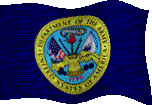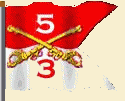Charlie Horse History Forward
20 Feb 1971
The Gun Platoon lost two plots KIA. Working the northwestern most portion of South Vietnam and north of the "Emerald City" location of the 3/5 Cav blocking force, the team was engaged by multiple 51 Cal anti-aircraft positions. Both Cobras were shot down. CPT Al Wester was able to perform a successful forced landing. He and his front seat, CPT Paul Carter, exited the downed aircraft. The second Cobra #67-15579 with 1LT John Hunter and his co-pilot WO Carl Nacca were engaging one of the 51 sites when they were hit by another 51 and were ablaze before hitting the ground at grid XD695494. The chase Huey commanded by AC WO Fred Blanchard extracted Wester and Carter while taking fire from at least one 51 site. As Charlie Horse elements scrambled into the air from Khe Sanh and Quang Tri, CWO John Winlow, "Batman 69," an AC in the 1/5th’s aviation platoon, climbed into WO Whipple's Cobra front seat. As short of pilots the Troop was finding itself, Batman pilots were volunteering to fill the vacant seats. They all knew the need for experienced eyes with a familiarity for the AO in the shorthanded Troop. None made themselves more available than Winlow. As the first to arrive at the crash site and after a quick briefing from WO Blanchard as to the situation, WO Whipple knew a hasty assessment of the burning Cobra was necessary to judge if anyone had survived. That assessment would set the pace and urgency of the recovery. With a low and slow pass over the wreck site while taking 51 fire, they both agreed that the crew had been killed instantly and were beyond assistance. The recovery operation was a dangerous affair requiring the elimination of the anti-aircraft sites and the Infantry insert into very hazardous territory.
Personal Recollections of CPT Tom Ford:
Months prior his loss, 1LT John Hunter and I were well into our cups one evening at the "Watering Hole." John coveted my air conditioner, a ragged but working affair I had inherited from the Platoon Leader I replaced, Bob Larkin. John wanted to know that if in the event of my early departure, would I “will it” to him. Now John possessed a "real" bed. Box spring and mattress with a wood head and footboard - an Air Force bed. There might have been three in the Troop. The CO had one of those. I agreed he could have the air conditioner but only if my departure proceeded his. If his departure proceeded mine I got his bed. We agreed, being ignorant of the near future plans for us and thought it in good fun more than a serious pact. Unbeknownst to us, WO Russ Whipple, John's cubicle partner, had overheard this drunken vow and registered it to memory.
At the end of the day and after John’s body was recovered, I had retreated to my quarters when I heard a scuffling outside the door. Looking out into the common area, I find WO Whipple struggling with a mattress and an already delivered box spring. "What are you doing Mr. Whipple?" seemed the logical question. Russ informed me that he had overheard the promise of the bed and being John Hunter's best friend, he was insuring that promise was fulfilled. Nothing I said would dissuade him. That night I slept on John Hunter's bed. I could feel the outline of his body imprinted onto the mattress. It was a fitful night's sleep and in sorrow.
Aircraft losses, and especially the losses of the experienced crews, were starting to negatively impact the Troop's ability to perform all the necessary tasks. Aircraft were being replaced from units still in the south, and while there were too many "Hanger Queens" being dealt to the Troop, it was the loss of the crews that hindered the scheduling. The losses of the OH-58's and the mounting Cobra losses were most troubling. BG Hill was aware of the shortage of crews experienced in the AO, so he assigned an FO to the Troop. LTC Ridgeway, the artillery CO, offered the service of LT Al Thornton, a Forward Observer from 5/4th Artillery. LT Thornton proved to be a sterling success and a great asset to the Troop. Now any aircraft in the Troop could take a standoff position from the NVA position and destroy it with accurate artillery fire. LT Thornton was excellent in his ability and he was amazed how easy it was to adjust fire from a vantage point of an aircraft. His addition to the Troop relieved the Cobra Platoon from missions requiring their exposure to ground fire and took some of the pressure off the newly emerging Cobra Aircraft Commanders. LT Thornton destroyed bunkers and fighting positions to the joy of whoever he flew with. The increasing level of NVA activity in the Tri-Border had LTG Sutherland and BG Hill wary of an NVA assault endangering the 3/5 Cav at "Emerald City." The increased rocket attacks on Khe Sanh were equally troubling. The 122mm rocket attacks and frequent sapper probes had the Command’s attention. The Troop’s missions were “slanted” toward those worries.

.gif)


